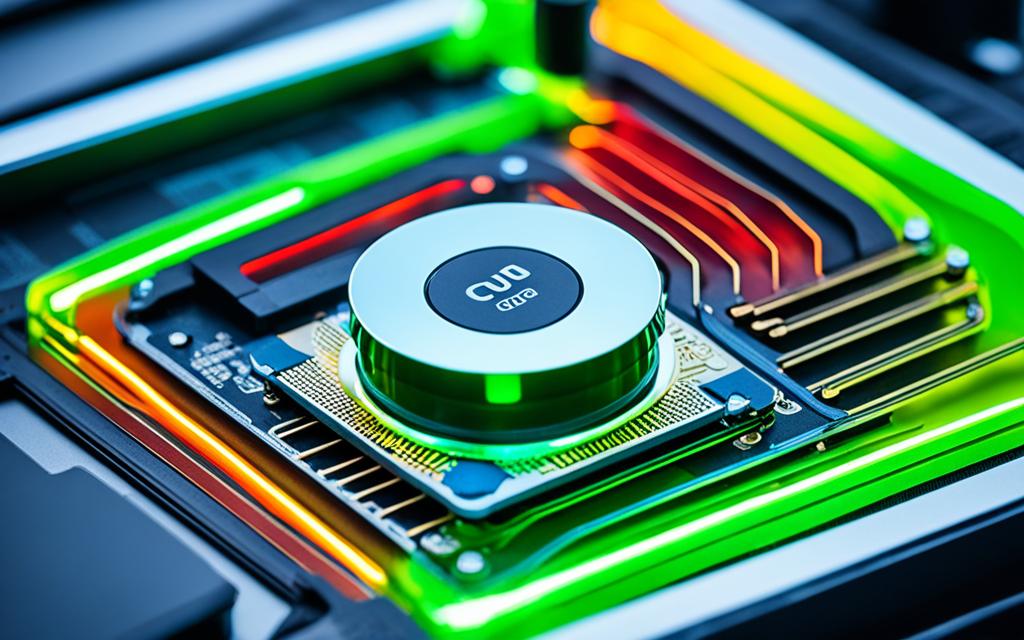Table of Contents
Keeping your CPU at the right temperature is key to making sure your computer runs well and lasts longer. The CPU is like the brain of your computer. It heats up when it works. If it gets too hot, the computer won’t work as it should. It’s important for everyone to know what temperatures are okay for their CPU. At rest, a CPU’s temperature should be between 30°C (86°F) and 40°C (104°F)1.
When you’re doing something that makes the CPU work harder, like playing demanding games, the temperature can go up. It might reach between 70°C (158°F) and 80°C (176°F)1. Keeping the CPU too hot for too long can hurt your computer. It could even shorten its life. That’s why you should always keep an eye on the temperature. Make sure you clean the inside of your computer to stop dust from making it hot. It’s also good to have a cooling system that works well to keep the heat down. If you want tips on how to keep your CPU cool, check out this guide.
Key Takeaways
- Recommended idle CPU temperatures are 30°C to 40°C (86°F to 104°F).
- Under heavy load, temperatures can rise to 70°C (158°F) to 80°C (176°F).
- Modern CPUs can handle temperatures up to 100°C (212°F) with adequate cooling solutions.
- Consistent monitoring and maintenance are necessary for optimal CPU performance.
- Regularly clean CPU components and consider upgrading cooling systems if needed.
Understanding CPU Temperature Ranges
Knowing how warm CPUs can get is key for their best work and long life. It’s good to keep an eye on CPU temperatures when it’s not busy and when it’s working hard. This helps to make sure it stays in a safe heat range. A CPU that’s not too hot shows it’s working well and staying cool enough.
Idle Temperatures
CPU temperatures usually stay between 30°C to 40°C (86°F to 104°F) when they’re not doing much2. This tells us that the cooling systems are doing their job right when the CPU isn’t busy. If temperatures go above this, there could be problems like system crashes or harm to the hardware3. So, keeping the CPU cool when it’s idle is crucial for top performance.
Load Temperatures
When a CPU works harder, like during games or intense tasks, we need to check its warmer temperatures. Under normal heavy use, CPUs should be okay if they’re between 40°C and 80°C (104°F and 176°F)4. But for very demanding jobs, temperatures might go from 60°C to 90°C (140°F to 194°F)4. If it gets hotter than this for too long, the CPU could slow down or get damaged permanently3.
| Condition | Temperature Range | Comments |
|---|---|---|
| Idle | 30°C – 40°C | Shows good cooling and low usage2. |
| Normal Load | 40°C – 80°C | Within safe levels for most CPUs4. |
| Heavy Load | 60°C – 90°C | High-end CPUs can get quite hot4. |
By carefully watching temperatures and following advice, users can make sure their CPUs work safely. This helps both performance and how long they last.
What Temp Should My CPU Run At
Knowing the ideal CPU temperature is crucial for top performance. When idle, CPUs stay cool between 30°C and 40°C (86°F to 104°F). During regular tasks, a good range is 40°C to 65°C (104°F to 149°F)56. For intense activities like gaming, it’s safe between 70°C to 80°C (158°F to 176°F)51.
Most modern CPUs handle heat variations well. However, constantly going over 80°C may cause thermal throttling. This drops performance to prevent damage1.
Ideal Temperature Specifications
The safe temperature for CPUs aids in their durability and steadiness. A temperature over 90°C (194°F) is risky and harmful6. Aim to keep it between 40°C and 60°C (104°F to 140°F) for daily use6.
To better manage CPU thermal management, try regular cleanings, applying thermal paste correctly, and using effective coolers. Dust and poor coolers can raise CPU temperature, harming its performance long-term1.
Use tools like Core Temp and HWMonitor for monitoring heat. They provide updates in real-time. This prevents exceeding safe temperatures. Keeping within limits boosts performance and extends hardware life monitoring your CPU temperature.
Factors Influencing CPU Temperature
It’s important to know what affects CPU temperature to boost its performance. The types of CPU, cooling methods used, and environment are key. They all help control how much heat is produced.
Type of CPU
CPUs have different heat responses. Idle modern CPUs range from 30°C to 40°C. But under heavy use, they can hit 60°C to 85°C. Intel CPUs max out at 100°C. If they go over 99°C for too long, their performance drops78.
Cooling Systems Used
The better the cooling system, the cooler a CPU stays. Switching to better coolers, like the Cooler Master Hyper TX3, keeps temperatures near 80°C. Normal coolers might let the CPU get as hot as 100°C under a lot of use8. Liquid metal and advanced air coolers are now competing with liquid cooling systems. They’re becoming more effective and user-friendly.
Ambient Environment Conditions
Room temperature and PC case airflow significantly affect CPU heat. Keeping your space clean helps. So, dusting fans and other parts boosts cooling effectiveness7. Managing both the inside and outside temperatures is key for a CPU to work well for a long time.
Monitoring Your CPU Temperature
Checking your CPU temperature is key to avoid overheating and keeping your computer running well. Using BIOS temperature monitoring is one good way to do this. When you start your computer, go into the BIOS setup to see your CPU’s temperature. This method helps you check your CPU’s condition, but it might not show changes in real time. This is especially true when your computer is working hard. It’s best if the CPU stays below 80°C when under stress9.
Using Built-in BIOS Tools
Using the BIOS to check your CPU temperature is easy and effective. Just boot into the BIOS menu and look for the CPU temperature section. While helpful, this method doesn’t track temperature changes over time. This could be a drawback during heavy computer use. For those who often do demanding tasks, knowing your CPU’s temperature limits is essential. For example, AMD’s Ryzen CPUs can safely operate up to 95°C9.
Third-Party Software Solutions
For ongoing monitoring, consider third-party CPU monitoring software. Programs like Core Temp and iStat Menus track your CPU temperature in real time. They even warn you if the temperature gets too high. This is very helpful for gaming or video editing, where temperatures can exceed 80°C910.
Tools like Fanny for Mac are free and easy to use. Using these tools often can help you prevent overheating. This ensures your computer works well, even when you’re running demanding apps11.
FAQ
What are the normal idle temperatures for my CPU?
When your CPU is not doing much (1%-10% usage), the temperature should be between 30°C and 40°C (86°F to 104°F). This shows your cooling systems are working right. It also means your processor is in a good state.
At what temperatures does my CPU operate under load?
Your CPU gets hotter when doing intense tasks, like playing games or video editing. It can safely get as hot as 60°C to 70°C (140°F to 158°F). Always keep an eye on these temperatures to avoid overheating issues.
What is the ideal temperature for optimal CPU performance?
The best temperature for your CPU is 30°C to 40°C (86°F to 104°F) in a resting state. Under heavy use, up to 80°C (176°F) is okay. If it gets hotter than 80°C, performance might drop to prevent harm.
How does the type of CPU affect its operating temperature?
CPUs from Intel or AMD have their unique heat behaviours and limits. Knowing your CPU’s specific heat limits helps manage its temperature better.
What role do cooling systems play in CPU temperature control?
Whether you use fans, liquid, or no fans for cooling, it greatly affects CPU temperature. Good cooling prevents your CPU from getting too hot.
How can ambient temperature affect CPU performance?
The room’s temperature can change how hot your CPU gets. Warmer rooms can make CPUs hotter, so keep both inside and outside temperatures in check.
What tools can I use to monitor my CPU temperature?
You can see CPU temperatures in the BIOS at startup. For continuous checking, use apps like Core Temp. They alert you if your CPU is getting too hot.
.
Q: Why is it important to regularly monitor CPU temperatures?
Keeping an eye on CPU temperatures helps avoid overheating. This ensures your computer works well, stays efficient, and lasts longer.
Source Links
- https://www.noyafa.com/blogs/knowledge-base/good-cpu-temperature – What Is A Good CPU Temperature? A Guide to Keep Your Processor Cool
- https://gadgetmates.com/normal-cpu-gpu-temperatures-for-your-pc – Normal CPU & GPU Temperatures For Your PC – GadgetMates
- https://www.lenovo.com/us/en/glossary/what-is-cpu-temperature/ – Cpu Temperature: What is CPU Temperature?
- https://www.linkedin.com/advice/3/what-normal-optimal-ranges-cpu-temperature-different – What are the normal and optimal ranges of CPU temperature for different types of processors?
- https://www.avast.com/c-how-to-check-cpu-temperature – How to Check and Monitor Your CPU Temperature
- https://community.spiceworks.com/t/what-is-a-normal-temperature-for-a-cpu-and-how-do-i-keep-it-low/948818 – What is a normal temperature for a CPU and how do I keep it low?
- https://us.vaio.com/blogs/innovation-hub/how-to-monitor-your-cpu-temperature – How To Monitor Your CPU Temperature
- https://www.pugetsystems.com/labs/articles/impact-of-temperature-on-intel-cpu-performance-606/ – Impact of Temperature on Intel CPU Performance
- https://www.tomshardware.com/how-to/how-to-check-cpu-temp-temperature – How to Check Your CPU Temperature
- https://www.pcmag.com/how-to/how-to-monitor-your-cpu-temperature – cpu temperature monitor
- https://www.avg.com/en/signal/check-cpu-temperature – How to Check and Monitor CPU Temperature on Windows and Mac












